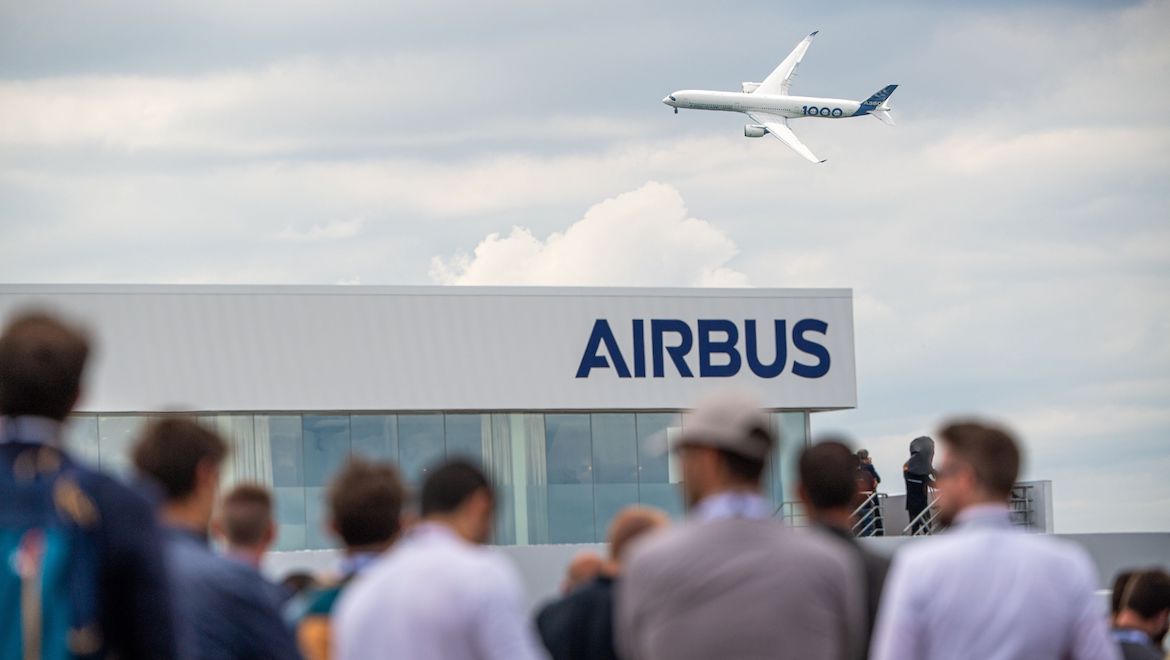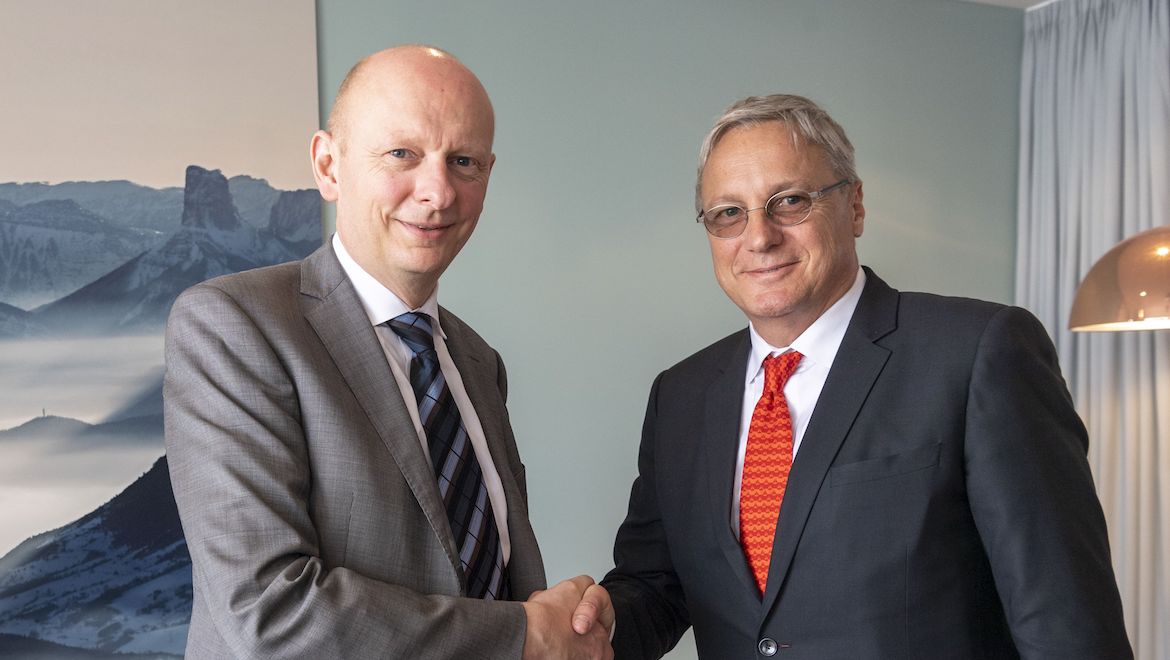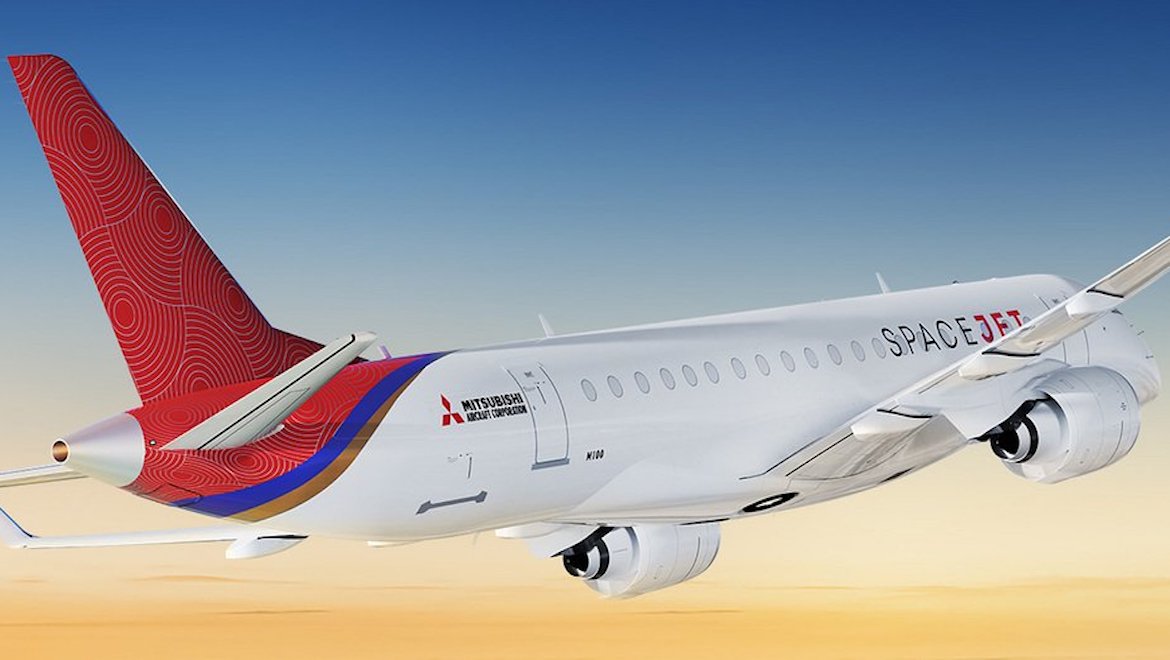John Walton sums up all the orders and announcements at the 2019 Paris Air Show at the end of the trade days at Le Bourget.

Torrential rains on the morning of the final trade day of this year’s Paris Air Show provided all the metaphorical dramatic irony the aviation industry needed to sum up this most unusual of shows in the most unusual of contexts.
Stormclouds turned into sunshine, leaking chalets dried out, and seemingly impassable lakes on the Le Bourget tarmac drained away.
Airbus trickled out orders until the very close of play and beyond, while Boeing closed its show with yet more apologies for its 737 MAX program, and some key behind-the-scenes supplier and conversion news also emerged.
Airbus finished strongly at the 53rd Salon du Bourget
With three orders after Airbus’ the final wrapup calculations were completed, the European airframer punctuated a very successful show in an unusual context not of its own making. Major success came from the A321XLR, with a good showing also for the smaller A220 and progress too for the A330neo.
Lessor NAC picks up 20 A220s
Nordic Aviation Capital, a large specialist regional lessor, signed a memorandum of understanding with Airbus for 20 Airbus A220 aircraft, formerly known as the Bombardier CSeries. Customers were not disclosed for the deal from the lessor, which serves more than 76 airlines in 51 countries.
It’s been a strong air show for the A220, with the NAC deal bringing the order total for the regional jet to 85, including 50 from Air Lease Corporation, 10 from an undisclosed customer — which Airbus confirmed was an airline rather than a lessor – and a further five from Delta Air Lines in the United states.

Flynas adds 10 A321XLRs and swaps 10 A320neos for A321neos.
A couple of hours after the main count of the show was finished, Airbus announced that it signed a memorandum of understanding with Saudi Arabian low-cost carrier (LCC) Flynas. The airline will upgauge 10 of its existing A320neo order to the A321neo, and also take a further new 10 Airbus A321XLR.
Flynas presently has 30 A320ceos and two A320neos and operates both domestically and internationally.
JetBlue converts to the XLR, adds A220s
Just before the doors closed on the final day of the Paris Air Show, US carrier jetBlue said it would convert 13 of its existing A321neo orders into firm orders for the A321XLR, as well as ordering 10 A220-300 jets from purchase options it already held.
Earlier in 2019, jetBlue converted 13 of its A321neo order — standing at 85 in total — to the long-range A321LR. The carrier presently operates about 200 Airbus A320 and A321 aircraft as well as a fleet of Embraer E-Jets that are to be replaced by its incoming A220 order.

Airbus wraps the middle of the market with the A321XLR and the A330neo
Excluding the orders above in its totals, Airbus added a total of 363 aircraft to its order book, of which 149 were firm orders and 214 what the airframer classified as “commitments”: memoranda of understanding, letters of intent, and other less binding deals.
The A320neo family alone saw 127 orders and commitments from customers comprising at least four airlines and two lessors: 36 of the aircraft were attributed to “undisclosed”.
The airframer also secured 352 upgauges, converting existing orders into larger and more capable — and thus more expensive — aircraft. These were largely from A320neo to A321neo and A321XLR jets.
Aside from any wider market implications in terms of winning the middle of the market, any upgauge is a broad positive for Airbus (and indeed any manufacturer) because the marginal cost of producing a larger aircraft within the same family is much smaller than the marginal benefit of selling it for a higher price.
In other words, a less expensive A319 takes up the same amount of factory floor space and time as a more expensive A321XLR.
The A321XLR won an impressive 226 orders in its first airshow outing from a range of customers that Airbus pointed to as validation for its size strategy in the middle of the market.
The largest single airline placing an order and/or commitment was from American Airlines with 50 A321XLRs, while Indigo Partners ordered a further 50 to split between three of its brands, Wizz AIr, Frontier and JetSMART.
Qantas ordered 36 and Air Lease Corporation 27, while 20 are marked “undisclosed”. Saudia picked up 16, IAG 14 for Iberia and Aer Lingus, Cebu Pacific 10 and Middle East Airlines 4.
At the other end of that middle of the market, the airframer said that the A330neo “has built on its positive market reception” thanks to two orders: 16 from ultra-low cost carrier Cebu Pacific and eight from Virgin Atlantic. The UK-based Virgin Atlantic will also take a further six from Air Lease Corporation.
Securing orders for the A330neo from an airline renowned for its premium passenger experience and from a ULCC is good news for Airbus and for the aircraft.
Also, the Airbus A220 continued its momentum, with orders for 85 aircraft, comprising 50 from Air Lease Corporation, a key bellwether customer, 20 from Nordic Aviation Capital, 10 from an undisclosed customer and five from Delta Air Lines.
The #PAS19 Day 4 underscored Airbus’ achievements across divisions, demonstrating customer endorsements for commercial aircraft, reinforcing the #FCAS progress & securing Airbus Commercial Helicopters’ first Chinese customer for the #ACH160. Read more: https://t.co/gf8qiOFoHR pic.twitter.com/X1bflRdJXR
— Airbus LIVE (@AirbusLIVE) June 20, 2019
Boeing sells 200 737 MAX and a few dozen widebodies
Altogether, Boeing sold via a letter of intent (LOI) with IAG for 200 737 MAXes or as IAG called them the 737-8 and 737-10. It was Boeing’s largest deal of the show by far, with a scattering of other orders in this most abnormal of years, where muted executives continued to apologise for the ongoing 737 MAX crisis.
Korean Air ordered 20 Dreamliners, split between the 787-9 and 787-10, and will lease a further 10 787-10s from Air Lease Corporation.
For its part, Air Lease took a further five 787-9s to top up its order books.

Qatar Airways picked up five 777 freighters of the current generation, with its perennially ebullient boss Akbar al Baker pressing Boeing to develop a freighter version of the re-engined 777X generation.
Thank you to our customers for their continued trust, support and confidence in our products and services. Sharing a few proud moments from the week.
See all the #PAS19 activity here: https://t.co/68qiXFrpL5 pic.twitter.com/F4vxnZ8Eun
— The Boeing Company (@Boeing) June 20, 2019
China Airlines from Taiwan selected “up to six” Boeing 777 freighters, while in the most amusing order of the show Turkmenistan Airlines ordered a whopping one 777-200LR.
ASL Aviation Holdings, parent company of a variety of aviation-related businesses, selected 20 of the passenger-to-freighter 737-800BCF conversions, while lessor GECAS ordered a total of 25.
Ready for takeoff. Day four of #PAS19 has come to an end. Take a look at a few of our favorite moments. pic.twitter.com/o3J0HgjU6o
— The Boeing Company (@Boeing) June 20, 2019
SpaceJet forges forward with supplier agreements
As the show drew to a close Mitsubishi Aircraft Corporation carried the momentum of its renamed SpaceJet, previously the MRJ, with new partnerships between the airframer and four key suppliers, as it transitions the cleansheet regional jet to its new space in the market.
“This week’s partnership agreements are a reflection of a growing recognition that there is real opportunity in the regional segment of the aviation market,” the company’s head of global strategy and business development Dave Barrow said.
“Our partnerships are a critical aspect of our ability to deliver a game-changing product to market.”
Engineering services will come from an agreement with the Triumph Group, whose Aerospace Structures unit would provide support of aircraft design and development.
“The contract leverages Triumph’s core structural engineering resources to provide airframe design and analysis support for the aircraft’s development, in particular related to wing optimization and access to advanced material technology,” Mitsubishi said.
Also, Spirit AeroSystems will supply engineering services in addition to the pylon contract already in place for the SpaceJet.
“In addition, Spirit is being considered for airframe structure work, extending their contract from the pylon manufacture for the SpaceJet M100,” says Mitsubishi.
Mitsubishi also signed a memorandum of understanding (MOU) with Safran Cabin, formerly Zodiac Aerospace, for “full-scale integrated interiors including galleys, lavatories, overhead bins, passenger service units, sidewalls, ceiling panels, as well as other components that create the customer experience during flight operations”.

Lessor BBAM inks LOI for Airbus A321 passenger-to-freighter conversion
At a show where a major part of Boeing’s orders were passenger-to-freighter narrowbody conversions, aircraft leasing company BBAM signed a letter of intent for an A321 converted freighter with the A321 P2F (passenger-to-freighter) program comprising Airbus, Elbe Flugzeugwerke (EFW) and ST Engineering.
Airframe-wise, the containerisation-ready A320 family is well suited to this sort of conversion, with 14 main deck container positions and 10 lower deck container positions holding 27.9 tonnes of freight, with a range of 2,300nm.
“As the first conversion solution to introduce a containerised lower deck in the segment of narrowbody freighters, the A321P2F has the potential to be the game changer for any hub and spoke operation, and to greatly help realise the projected global air cargo growth rate,” BBAM chief executive Steve Zissis said in a statement.
On behalf of the A321 P2F partnership, Elbe Flugzeugwerke chief executive Dr Andreas Sperl said: “We are pleased to welcome BBAM as one of our prestigious P2F customers. Given the track record we have in redelivering converted freighters with the support and resources from parent companies, ST Engineering and Airbus, we are confident in meeting BBAM’s requirements for this first conversion, and we look forward to engaging them soon in the near future for follow-on conversion projects.”
The conversion of the A321 to a 14-pallet cargo configuration was expected to begin in mid-2020 and be completed by the end of 2020.
















